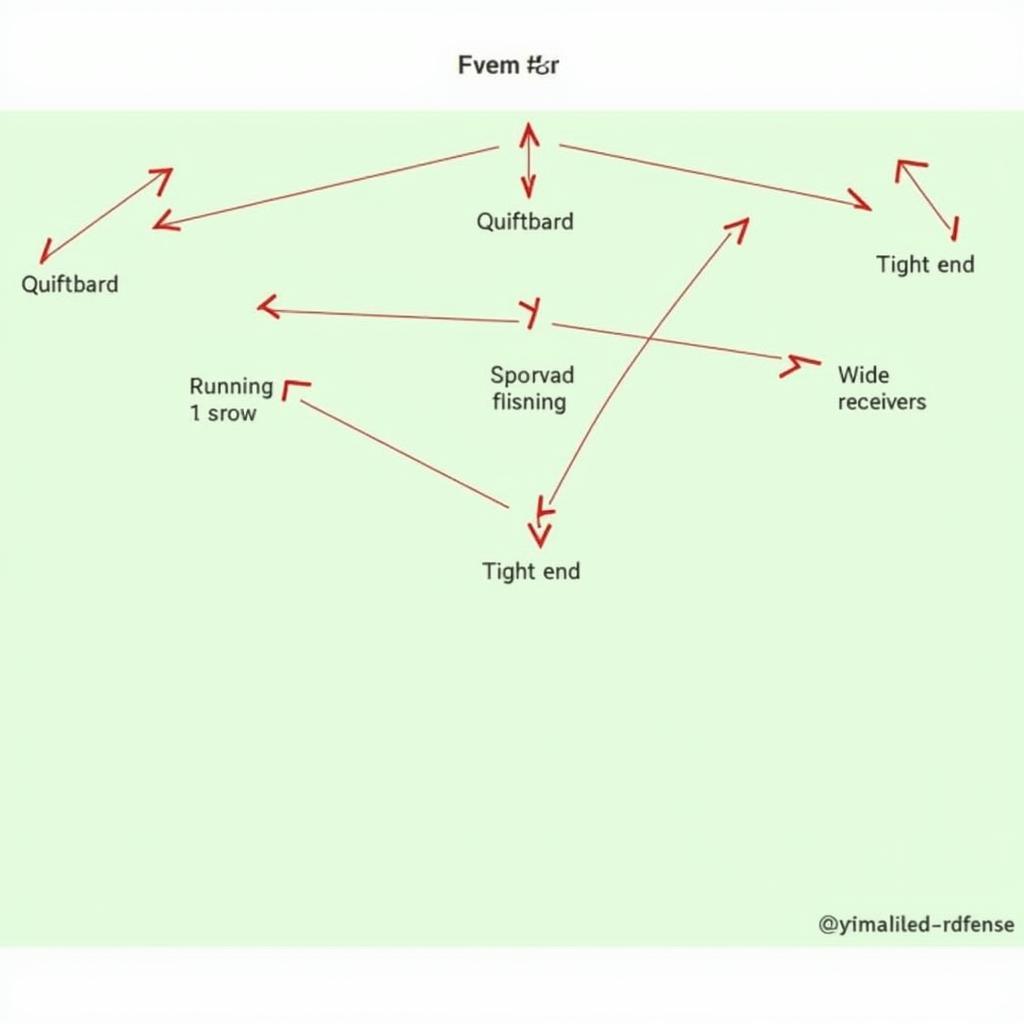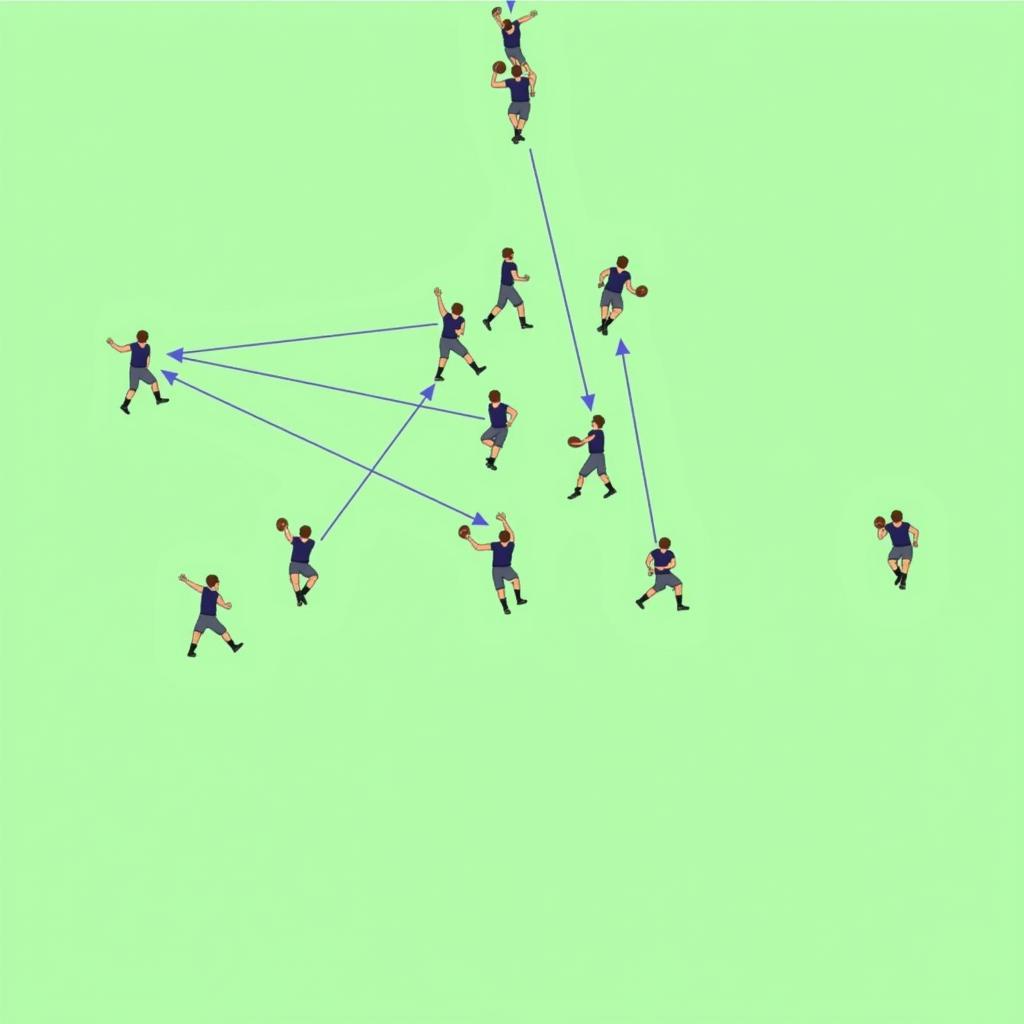The One Back Offense, a staple in modern football, prioritizes versatility and strategic play-calling. By employing a single running back and spreading the field, this offensive scheme presents a multitude of options that keep defenses guessing.
 One Back Formation
One Back Formation
Decoding the One Back Offense
Unlike traditional formations with multiple running backs, the one back offense revolves around a single running back positioned behind the quarterback. This setup provides a balanced offensive approach, capable of exploiting both running and passing opportunities.
The core principle of this offensive scheme lies in its adaptability. With a diverse playbook at their disposal, coaches can tailor their game plan to exploit specific defensive weaknesses. The one back offense thrives on creating mismatches and forcing defenses to cover the entire field.
 Run-Pass Options in One Back Offense
Run-Pass Options in One Back Offense
Advantages of the One Back Offense
The popularity of the one back offense stems from its numerous advantages:
- Flexibility: The scheme allows offenses to seamlessly transition between running and passing plays, keeping defenses off-balance.
- Spreads the Field: By utilizing multiple receiver sets, the one back offense stretches the field horizontally, creating space for receivers and the running back.
- Creates Mismatches: The formation often forces defenses into man-to-man coverage, creating favorable matchups for the offense to exploit.
- Pass Protection: Having five players potentially staying in to block provides the quarterback with ample time to survey the field and make decisions.
Key Positions and Responsibilities
Each position within the one back offense carries specific responsibilities crucial to its success.
- Quarterback: The quarterback acts as the field general, responsible for reading the defense, making pre-snap adjustments, and choosing the optimal play.
- Running Back: More than just a ball carrier, the running back needs to be an adept pass-catcher and blocker, contributing significantly to both facets of the game.
- Wide Receivers: With the field spread, receivers play a crucial role in gaining separation from defenders and creating passing lanes for the quarterback.
- Tight End: The tight end serves a hybrid role, acting as both a receiver and an additional blocker, providing critical support in both run and pass plays.
- Offensive Line: The foundation of any successful offense, the offensive line is tasked with protecting the quarterback and creating holes for the running back.
Mastering the One Back Offense: Essential Strategies
Effective execution of the one back offense necessitates a deep understanding of its intricacies:
- Run-Pass Options (RPOs): RPOs are a cornerstone of the one back offense, giving the quarterback the ability to choose between a handoff, a pass, or even keeping the ball based on the defense’s reaction.
- Play-Action Passing: The threat of a strong running game enhances the effectiveness of play-action passes. By faking a handoff, the quarterback can deceive the defense and create opportunities for big plays downfield.
- Screen Passes: Quick screen passes to the running back or receivers offer a way to gain yardage against aggressive defenses and take advantage of open space.
“The beauty of the one back offense lies in its adaptability,” says Coach John Smith, a seasoned offensive coordinator with over 15 years of experience. “It’s like a chess match. You’re constantly looking for ways to outmaneuver the defense by exploiting mismatches and creating confusion.”
Variations of the One Back Offense
Several variations of the one back offense have emerged, each with its own nuances:
- Spread Offense: Characterized by three or more wide receivers, the spread offense prioritizes passing and stretches the field horizontally.
- Pistol Offense: The quarterback lines up further back from the center in the pistol formation, providing a balanced look for both run and pass plays.
- Pro-Style Offense: Often employed at the professional level, the pro-style offense incorporates a blend of formations and play calls, demanding versatility from its players.
Choosing the right variation depends on the team’s personnel and the opponent’s defensive tendencies.
Conclusion
The one back offense has revolutionized the game of football, offering a balanced and versatile approach to scoring points. By mastering the key concepts, utilizing diverse play-calling, and adapting to defensive strategies, teams can effectively employ this dynamic offensive scheme to dominate the gridiron.
To learn more about specific offensive strategies like the pistol offense playbook or compare different offensive approaches like the double wing offense, browse our comprehensive resources on VNG Game.
FAQ
1. What are the biggest challenges for defenses facing a one back offense?
Defenses often struggle with the one back offense’s unpredictability. The ability to run or pass effectively from the same formation forces defenses to account for multiple threats.
2. What type of running back excels in a one back offense?
Versatility is key. A successful one back running back needs to be a capable runner, receiver, and blocker.
3. How important is the offensive line in a one back offense?
The offensive line remains crucial, as they are responsible for protecting the quarterback and creating running lanes, especially with fewer blockers in the backfield.
4. Is the one back offense suitable for all levels of football?
Yes, the one back offense can be adapted for youth, high school, college, and even professional football.
5. What are some common mistakes teams make when running the one back offense?
Lack of execution, predictable play-calling, and failing to adjust to defensive adjustments are common pitfalls.
Need further assistance? Contact us at Phone Number: 0902476650, Email: [email protected] or visit us at 139 Đ. Võ Văn Kiệt, Hoà Long, Bà Rịa, Bà Rịa – Vũng Tàu, Việt Nam. Our dedicated customer support team is available 24/7. For insights into player comparisons, check out our articles on Derrick Henry or Breece Hall and Dalvin Cook or Javonte Williams. Additionally, you might find our analysis of Zay Jones or Courtland Sutton beneficial for understanding wide receiver dynamics.





